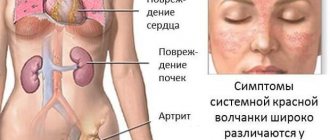What is this?
Steroid hormones are synthesized in the body from bile acids. Their synthesis is a chain of chemical transformations with complex regulation. Women are probably familiar with the sex hormone progesterone. Its effect on the reproductive system is one of the mechanisms that contribute to preparation for conception and maintaining pregnancy. Progesterone is produced in the ovaries, and during pregnancy in the placenta.
Progesterone metabolism occurs in the ovaries and adrenal cortex, and during pregnancy, in the placenta. When it is hydroxylated, that is, the OH group is added to the 17th carbon atom, 17 oh progesterone, or hydroxyprogesterone (17 OP), is formed. This is a hormonal substance that, through a series of chemical reactions, is converted into cortisol, testosterone or estradiol.
Normally, an increase in the synthesis of cortisol from hydroxyprogesterone occurs in stressful situations, when a feeling of fear appears. Its role is to prepare the body to “repel an attack.”
Cortisol is a stress hormone that is formed during the metabolism of 17 OP, causing an increase in blood pressure, a rush of blood to the heart and muscles, and the release of a large amount of energy due to the saturation of the blood with glucose.
A change in the amount of hydroxyprogesterone in the follicular phase of the menstrual blood cycle indicates a disruption in the production of other hormones (progesterone, cortisol, testosterone). This indicator is used to identify hormonal imbalances and clarify the diagnosis.
To do this, the level of the substance in the blood is determined in the follicular phase in women and at any time in men. By comparing the indicators with the norm, the presence of changes in hormonal levels is determined.
An increase in the concentration of hydroxyprogesterone occurs with an increase in its production from progesterone or a decrease in the formation of cortisol. Moreover, the rate of synthesis of sex hormones (androgens) usually remains the same.
This hormonal imbalance causes infertility in women, and if conception occurs, the development of frozen pregnancy, miscarriage, or placental insufficiency is possible. In addition, this can affect the gestation process and cause pathologies in the fetus.
This is due to the fact that if 17 OH progesterone is elevated, there is a hormonal imbalance in the body, most often expressed as a violation of the ratio of sex hormones and hyperandrogenism. Hyperandrogenism is the excessive formation of androgens (male sex hormones). This condition affects the maturation of eggs in the follicular phase and the maintenance of pregnancy.
Differences between 17-OH-progesterone and regular progesterone
The substances have a similar name, but their functions and effects on the body are different. Progesterone is a complete chemical that controls fertility. It is produced by the temporary gland of the appendages (corpus luteum), the endocrine glands and serves as a regulator of estrogen, regulating the endocrine background. The male body produces small amounts through the testicles, adrenal glands, and processes it into testosterone and cortisol.
The hormone 17-OH-progesterone is an independent chemical compound that serves as an intermediate in the synthesis of complex substances. Produced by the reticular zone of the gland cortex, reproductive organs, placental tissues of the gestation period, through complex metabolic changes. Enzymes break down the substance into cortisol and androstenedione.
Norms at different periods of life
In a newborn in the first days of life, progesterone is normally elevated. This is especially evident in premature babies. Then within 5-7 days it decreases and remains low until puberty. During the formation of sexual characteristics, an increase in the level of the hormone in the blood is observed.
In men of reproductive age, the amount of 17 OP in the blood is 1.55–6.4 nmol/l, and the values may differ in different laboratories. Usually, when conducting tests, reference values (normal values) are given along with the result for comparison.
In women with the onset of menstruation, a cyclic change in hydroxyprogesterone is observed, they correspond to the level of adrenocorticotropic hormone (ACTH), responsible for the synthesis of cortisol. Normal values in nmol/l throughout the cycle are:
- follicular phase - 1.25–8.3;
- in the ovulation phase - 0.9–4.3;
- luteal phase - 0.85–8.6.
Normally, 17 OH progesterone in the follicular phase should have low values. It rises slightly before ovulation. The peak of the rise corresponds to the maximum level of luteotropic hormone in the blood. Then the indicators decrease to a certain level. They remain this way until the end of the menstrual cycle, unless conception occurs.
In the case of fertilization of the egg and implantation, due to the functioning of the corpus luteum, the amount of hydroxyprogesterone increases. Its increase occurs throughout pregnancy and ranges from 3.35 to 33.5 nmol/l. A repeated decrease in the hormonally active substance is observed before childbirth.
The table shows normal values of 17 OD in ng/ml.
That is, hydroxyprogesterone gradually increases in the follicular phase, then its level remains stable until the onset of menstruation.
Thyroid-stimulating hormone (TSH, thyrotropin)
A glycoprotein hormone that stimulates the formation and secretion of thyroid hormones.
It is produced by basophils of the anterior pituitary gland under the control of thyroid-stimulating hypothalamic releasing factor, as well as somatostatin, biogenic amines and thyroid hormones. Increases vascularization of the thyroid gland. Increases the supply of iodine from blood plasma to thyroid cells, stimulates the synthesis of thyroglobulin and the release of T3 and T4 from it, and also directly stimulates the synthesis of these hormones. Enhances lipolysis.
There is an inverse logarithmic relationship between the concentrations of free T4 and TSH in the blood.
TSH is characterized by daily fluctuations in secretion: blood TSH reaches its highest values at 2 - 4 am, the highest level in the blood is also determined at 6 - 8 am, the minimum TSH values occur at 17 - 18 pm. The normal rhythm of secretion is disrupted when awake at night. During pregnancy, the concentration of the hormone increases. With age, the concentration of TSH increases slightly, and the amount of hormone emissions at night decreases.
Limits of determination:
0.0025 mU/l-100 mU/l.
How to get tested
17 oh progesterone is checked both when complaints or certain symptoms appear, and for preventive purposes or when certain diseases are suspected.
Indications for the purpose of analysis are as follows:
- hirsutism;
- acne;
- intermenstrual bleeding;
- amenorrhea, other menstrual irregularities;
- soreness of the mammary glands;
- infertility;
- miscarriage;
- suspicion of adreno-cortical syndrome, congenital dysfunction;
- tumors of the ovaries, adrenal glands.
Since the level of hydroxyprogesterone changes throughout the day - it is increased at dawn and decreases in the evening, blood is taken for analysis before 10 a.m., on an empty stomach. It is important to avoid stress, nervous and physical strain the day before and on the day of the examination, as this can lead to a false positive result.
Men can get tested any day. Women should be tested for progesterone 17 in the follicular phase of the menstrual cycle on days 3–5. You can check the concentration of hydroxyprogesterone in the luteal phase, along with other hormones, since there are special tables with average data that determine the norm on any day of the cycle. But if a woman becomes pregnant and does not yet know about it, then the readings will be different, since during pregnancy 17 OP increases. Therefore, it is better to get tested in the first phase or make sure there is no pregnancy.
If hydroxyprogesterone is elevated, then you may need to check other hormones (progesterone, DHEA, testosterone) and undergo instrumental examination (ultrasound, CT, MRI).
Optimal level
How is Progesterone normal in women calculated? To judge the concentration of the hormone in the blood, it is necessary to take into account the physiological state and age:
| Women | Nmol/l | ng/ml |
| Girls from 12 to 17 years old | 0,1 – 7,0 | 0,03 – 2,3 |
| Women over 17 years old | 0,2 – 8,7 | 0,07 – 2,9 |
| During menstrual bleeding (follicular phase) | 0,2 – 2,4 | 0,07 – 0,8 |
| On days 20-22 of the cycle (luteal phase) | 0,9 – 8,7 | 0,3 – 2,9 |
| During pregnancy | 2 – 12 | 0,66 – 4 |
The level of the hormone in the blood is important for identifying the etiology of the following abnormalities:
- against the background of the absence of gynecological visible pathologies, a woman does not become pregnant for six months or longer;
- a woman grows hair on her face, chest and back;
- monitoring the outcome of treatment for adrenal diseases;
- the menstrual cycle is disrupted;
- symptoms of hormonal imbalance;
- pathologies of the adrenal glands.
Blood sampling for 17OH progesterone analysis is carried out in accordance with the rules :
- blood is donated from a vein on an empty stomach;
- the collection should be carried out on days 3-5 of the cycle, otherwise the result will be uninformative;
- Before collecting material, you can drink water, no more than 0.5 liters.
Important!
A blood test for oxyprogesterone must be taken as part of a pregnancy planning program in order to protect the unborn baby from abnormalities in the functioning of the adrenal glands.
Reasons for the increase
If 17 OH progesterone is elevated in the follicular phase, this may indicate various pathologies, so the analysis must be deciphered, taking into account not only the patient’s complaints and medical history, but also the indicators of other hormones. Most often, hydroxyprogesterone increases with the following pathologies:
Congenital dysfunction of the adrenal cortex
Occurs due to deficiency of enzymes involved in the synthesis of cortisol. Currently, cases of deficiency of 7 different enzymes have been described, but the most common are deficiencies of 21-hydroxylase and 11-beta-hydroxylase. The cause of the pathology is a genetic mutation. A deficiency of the enzyme leads to a decrease in cortisol in the blood and, through feedback, to increased production of ACTH, which stimulates the production of hydroxyprogesterone and its accumulation in the body. At the same time, androgen production continues, leading to hyperandrogenism. Signs of virilization, acne, hirsutism - hair growth, alopecia - loss, fragility, thinness of hair on the head appear. To clarify the diagnosis, hormonal levels are determined, stress tests for 17 OH progesterone, and genetic studies are performed.
Polycystic ovary syndrome
A disease associated with metabolic disorders due to instability of the endocrine system. Patients experience a change in the ratio of FSH and LH, increased secretion of testosterone and insulin. In the ovaries, ovulation does not occur; the follicles are transformed into numerous cystic formations that support the inflammatory process and cause sclerosis of the membrane. These are distinctive signs of pathology that are detected on ultrasound.
Itsenko-Cushing syndrome
A group of diseases in which there is a long-term effect of glucocorticoids on the body. The pathology is caused by increased production of AHTK, which can cause an increase in OP 17 in the blood.
Tumors
Tumors of the adrenal glands, ovaries, hormone-producing cysts. They also lead to hormonal imbalance through feedback.
Hypothalamic syndrome
It occurs as a result of injuries to the hypothalamus, psychogenic disorders, and during the restructuring of the body during pregnancy. May cause the development of Cushing's disease.
Taking progesterone medications
This is relevant for women with infertility who are indicated for IVF treatment.
There may be other causes of increased hydroxyprogesterone, so when choosing a treatment method, the patient should be carefully examined to establish an accurate diagnosis.
Complications
When 17 OH progesterone increases, one of the main complications of this condition is infertility. Moreover, even the use of assisted reproductive technologies may turn out to be useless, since termination of pregnancy is observed in the early stages (miscarriage, fading). Often women request early miscarriages or frozen pregnancies for examination.
And when it is discovered that OP 17 in the follicular phase is increased, they begin to look for the cause of the pathology in order to carry out appropriate treatment.
High levels of this hormone can also affect other body systems. For example, it causes overstrain of the cardiovascular system, and if the problem is not corrected in time, the risk of developing myocardial infarction increases.
Due to the effect of the substance on brain tissue, in particular on the hypothalamus, patients often note memory impairment and forgetfulness. Long-term exposure can lead to disturbances in brain activity and the appearance of mental disorders, since the hormone affects the receptors responsible for taste, joy, and pleasure. Patients' mood changes and depression appears.
You need to be very careful when taking medications that contain progesterone (Utrozhestan, Proginorm, etc.). They are used in the treatment of infertility and IVF. The dosage must be strictly observed, since excess progesterone in the blood has an immunosuppressive effect. If for implantation of an embryo it is necessary to reduce the woman’s immunity so that the body does not reject the fertilized egg as a foreign agent, then the excess content of hydroxyprogesterone leads to defenselessness against infections.
When is treatment required?
Even if 17 OH progesterone is found to be elevated, treatment is not always required. If only one analysis is performed, in the follicular phase, an increased concentration of hydroxyprogesterone may be associated with the following situations:
- The reagents used in the laboratory are more sensitive, so you need to compare the indicators with reference values, and not with a table of standards, which are usually indicated next to the result.
- Before the test, the patient was nervous, and fear causes an increase in the secretion of cortisol and 17 OP.
- The subject is taking progesterone medications.
In such cases, there is no need to worry; you should take the test again, properly preparing for it. When blood is donated during the luteal phase, a high concentration may indicate that the woman is pregnant, and this should be clarified. During pregnancy, it is more difficult to determine whether 17OH progesterone is elevated, so treatment is carried out only if its values exceed the norm by 2-3 times.
If treatment was prescribed for infertility, women are often interested in whether it needs to be continued after pregnancy has occurred. In such a situation, the doctor is guided by the degree of increase in indicators and the gender of the child. Since high hydroxyprogesterone in congenital adrenal hyperplasia causes virilization, the level of dehydroepiandrosterone sulfate (DHEA-S) should also be checked. And if it is high, treatment is prescribed only for high levels, for pregnant women carrying a female fetus, in order to avoid virilization and hermaphroditism.
How to reduce
Before starting therapy, the cause of the pathological condition should be established. This may require additional clinical studies of progesterone, testosterone, and other hormone levels. They also conduct special stress tests to identify congenital adrenocortical insufficiency, ultrasound diagnostics, computer and magnetic resonance imaging. Once the final diagnosis is made, a treatment plan is developed.
Decreased progesterone in PCOS and tumors
Infertility due to PCOS requires complex therapy. For this purpose, combined oral contraceptives (COCs) are prescribed, which correct the menstrual cycle and hydroxyprogesterone levels. If pregnancy does not occur after correction, other methods of therapy are used - stimulation of ovulation or surgical treatment with dissection of the sclerotic membrane of the ovaries.
Treatment tactics for hormone-producing cysts, ovarian tumors or adrenal tumors are usually surgical. The pathological focus is removed surgically. For corpus luteum cysts, in some cases, conservative therapy with COCs is possible. Only after this do they plan to become pregnant.
Decreased hormone levels due to adrenal dysfunction
Congenital adrenal dysfunction is treated with glucocorticoids. The medicine, dosage and duration of administration are selected by the doctor.
Dexamethasone or Methylprednisolone tablets are usually prescribed. The dose of the drug is divided into 2-3 doses per day. Therapy is carried out until 17 OH progesterone decreases, then the dosage of the drug is gradually reduced and pregnancy is planned.
During gestation, the pregnant woman is under the supervision of a doctor. The decision to continue therapy during pregnancy is made individually in each case. If the level of hydroxyprogesterone remains high and exceeds the norm by 2-3 times, hormonal therapy is again prescribed, especially when the female gender of the fetus is confirmed. In severe cases, the drug may need to be taken throughout life.
Treatment for Itsenko-Cushing syndrome
It can also be treated either conservatively (hormonal therapy) or surgically. For example, for pituitary tumors, it is possible to irradiate the affected area or remove the tumor.
Since hormonal drugs are used to reduce the level of 17 OP, treatment must be prescribed and monitored by a doctor. It is impossible to correct hormonal levels by other means, but they can be used as an additional factor.
Nutrition for high progesterone
Traditional medicine uses infusions of rowan flowers, cloves (flowers, buds), carrot seeds, hogweed stem and others. But you can take them only after consulting a doctor.
Proper dietary nutrition can also speed up treatment. A diet for such a pathology should include a minimum amount of protein products and be rich in vegetables and fruits. Dishes made from carrots, potatoes, beets, onions, and legumes (peas) are healthy. It is also necessary to saturate the body with vitamin C, which is abundant in citrus fruits, fresh herbs, sea buckthorn berries, and raspberries.
An increase in hydroxyprogesterone levels indicates hormonal disorders that are associated with various pathologies that require treatment and correction. It can cause infertility and miscarriage. Treatment is selected depending on the cause that caused the hormonal changes.










